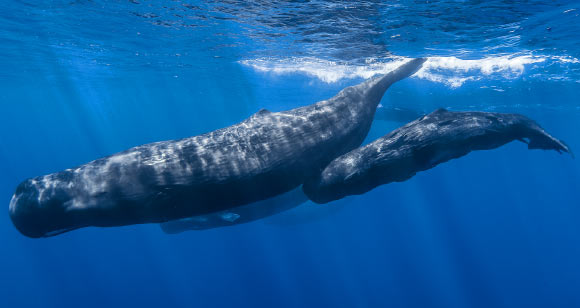Culture in animal societies is a highly debated topic. Some scientists think it’s clear enough, while others don’t think the word ‘culture’ should be used describing anything but humans. A new study, led by Mauricio Cantor of Dalhousie University, Canada, suggests that processes similar to those that generate human cultures could not only be at play in animal societies but also create multilevel social structures in the wild.

Sperm whales (Physeter macrocephalus) off the coast of Mauritius. Image credit: Gabriel Barathieu / CC BY-SA 2.0.
Since 2013, Cantor and his colleagues from the University of Colorado at Boulder, University of the Philippines Diliman, Georgia Institute of Technology, and the University of Notre Dame, studied sperm whales (Physeter macrocephalus) off the Galápagos Islands.
They examined two clans of sperm whales, observed in the Pacific since the 1980s, that share the same geographic area.
Despite living in the same neighborhood, each clan of whales developed their own ‘dialects’ composed of patterns of clicking sounds (codas).
Cantor and co-authors listened for the whales’ clicking sounds with a microphone to nail down their locations and study their coda repertoires.
Once the whales came to the surface to breathe, the scientists photographed their tails. The ridge of the tail is a sperm whale’s equivalent to a fingerprint. They matched codas and behaviors to individual animals.
After the fieldwork was complete, the biologists combined that data with previous data dating as far back as the 1980s to create virtual populations of whales using computer simulations.
Looking to investigate how the whales created two separate dialects, they simulated several scenarios with these virtual populations.
One examined individual learning: how the dialects would evolve if the whales created codas by themselves.
Another examined genetic transmission: how the dialects would evolve if they innately knew which codas to produce.
A third examined social learning: when whales could listen and copy the codas they hear from other whales.
Social learning could be biased; for instance, whales could conform to learn the most common codas, or learn from the individuals who produce similar codas, or use specific codas to mark the identity of the clans they belong to.
“Our findings show that biased social learning is a required ingredient for the segregation of clans of sperm whales with different dialects,” Cantor said.
“Through the simulations, it becomes evident that whales are learning how to communicate from each other – similar to how humans work. The whales in each clan are conforming to those most similar around them.”
“This gives us evidence that key features of human culture might be at play in populations of other animals. Maybe we’re not as different as we thought,” he said.
Showing that culture can be a mechanism structuring animal societies, this study will fuel the ongoing debate among researchers all over the world.
The findings were published this week in the journal Nature Communications.
_____
Maurício Cantor et al. 2015. Multilevel animal societies can emerge from cultural transmission. Nature Communications 6, article number: 8091; doi: 10.1038/ncomms9091







